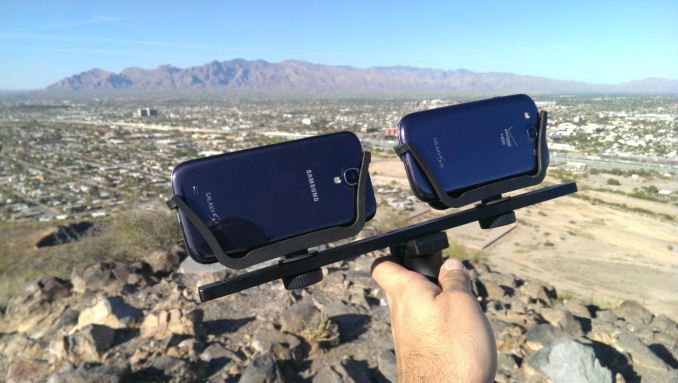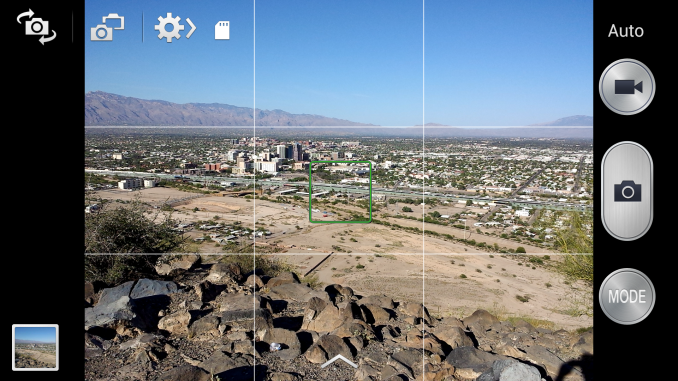Samsung Galaxy S 4 Review - Part 1
by Brian Klug on April 24, 2013 12:01 AM ESTCamera on SGS4
On the camera side Samsung is in an interesting position. The industry trend is overwhelmingly to go to more pixels and push the megapixel count up from 8 MP where most flagships sat last year to around 13 where they will sit this year. Samsung has to push that number to keep itself in a defensible and marketable position and at the same time deliver a camera experience that’s better than the previous year.
I published a table in the One review with the camera specifications from the previous generation. I’ve filled this in with confirmed information from the SGS4 review unit I have been taking samples with. With SGS4 Samsung does make some pretty considerable improvements, many of which undo some of the regressions that I described with SGS3. Focal length is now quite a bit longer, from the very wide SGS3 which was around 26mm in 35mm effective numbers, to 31 mm. This is a notable difference if you’re shooting with the two side by side, the SGS3 was always shockingly wide for a rear facing camera.
| Smartphone Camera Comparison - 2013 | |||||||
| HTC One | Samsung Galaxy S 2 | Samsung Galaxy S 3 | Samsung Galaxy S 4 | ||||
| Front Camera | 2.1MP | 2MP | 1.9MP | 2MP | |||
| Front Camera - CMOS |
OV2722 (1.4µm, 1/5.8") |
- |
S5K6A3 (1.75µm, 1/6") |
S5K6B2 (1.34µm, 1/6") |
|||
| Front Camera - Focal Length | ~1.59mm | 2.73mm | 2.7mm | 1.85mm | |||
| Front Camera - Max Aperture | F/2.0 | F/2.8 | F/2.8 | F/2.4 | |||
| Rear Camera | 4MP | 8MP | 8MP | 13MP | |||
| Rear Camera - CMOS |
ST VD6869 (2.0 µm, 1/3") |
S5K3H2YX (1.4µm 1/3.2") |
Sony/Samsung (1.4µm, ~1/3") |
IMX091PQ (1.12µm, 1/3.06") |
|||
| Rear Camera - Focal Length |
3.82mm (28mm eff) |
3.97mm (30mm eff) |
3.7mm (~26 mm eff) |
4.2mm (31 mm eff) |
|||
| Rear Camera - Max Aperture | F/2.0 | F/2.65 | F/2.6 | F/2.2 | |||
At the same time, F-number has improved dramatically, from the F/2.6 or 2.65 (I’ve seen both at times) aperture on the SGS3 to a much faster F/2.2. This dramatically improves the light collection abilities of the camera, by essentially a half stop. It’s difficult optical design to both keep the module thin enough to fit in the device without creating a huge bump (there’s a camera bump on SGS4, it’s there), increase focal length, improve F/#, and improve MTF for a better sensor all at the same time.
On the rear facing camera we see a Sony CMOS who continues to dominate the space, this time with an IMX091PQ sensor. On the front we Samsung’s own sensor, the S5K6B2 get used. Samsung also continues to go with a dedicated Fujitsu ISP inside the SGS4, this time it’s a new M10MO family which there isn’t a whole lot of information about. I suspect this continues to be done to mitigate the differences in SoC ISP between the APQ8064ab variant and Exynos 5 version and make tuning easier on Samsung’s camera team.
Imaging is increasingly a key differentiator for smartphones since it’s that device you always have on your person to take images with. For SGS4 camera is more of an emphasis this time around than it was with SGS3, which largely kept everything the same and just added software features. SGS4 brings better hardware and additional software features to do something with the hardware.
Outdoors in bright light the increased spatial resolution afforded from going from 8 MP to 13 MP helps. Samsung still does a lot of sharpening and there are halos around a ton of different features if you know where to look, but that’s the tuning they have opted for. I suspect we still are outresolving the sensor here, but I’m impressed with what I see with enough light. I took a lot of photos side by side with SGS3 and find SGS4 a notable improvement, but I’m not sure whether that’s just more damning commentary on SGS3 than anything else. I haven’t had time to put together many side by sides with buttons yet. I’ve been shooting with the HTC One on −2 sharpness since I prefer it that way, note that I accidentally left it this way with when making comparisons here since that’s still my daily driver until I can get an AT&T or T-Mobile SGS4 to use.
In lower light unsurprisingly we see the SGS4 offer better results than the SGS3 but still not quite as good as the HTC One. Samsung recently introduced low light shot on the SGS3 and Note 2, this feature carries over to the SGS4 but gets renamed back to Night Mode, even though behavior appears superficially to be the same. The SGS4 also introduces an auto night mode toggle, although this ships by default turned off. The mode automatically switches on night mode when it senses that you’re going to underexpose using the auto presets, I would advise basically leaving this on all the time. Unfortunately night mode introduces huge shot to shot latency that seems to be on the order of seconds — tap the button, capture runs, then there’s a progress bar that pops up while multiple exposures are ostensibly recombined into one image. You also have to be exceptionally steady to get an image without blur since it appears that this mode takes multiple images to get to the end goal — a better exposed image without tons of noise.
In the end there’s really no free lunch for anyone — you can temporally oversample (Samsung low light shot, or longer exposures with OIS like Nokia), or increase the size of your sampling area (larger pixels a-la HTC One), or do nothing and just give up unless you’re in a bright outdoor setting.
Samsung has introduced a bunch of new photo modes in the software on the SGS4, a number of which are actually pretty functional and awesome. There's the ability to create animated gifs from right in the camera, for example, where users paint a mask around the region they want animated from a short capture. This is essentially the same as Nokia's cinemagraph Lens from the Lumia 920, but it's still quite cool.
There's also dual camera, which lets you include a small overlay of the front facing camera atop the rear facing camera image. It initially struck me as a bit gimmicky but actually can be hilariously fun to share your face atop images to friends. It is also quite possibly the stuff of nightmares.
Panoramas on the SGS4 also are nicely put together and integrate continuously rather than get combined from a number of discrete images. The result is quite nice.
The user interface on SGS4 is a departure from the interface which has been present on previous Galaxy smartphones, and instead takes much UI/UX from the Galaxy Camera. Gone are the customizable toggles on the left side, instead options are in an expandable menu at the very top, and then another separate window. I got used to it pretty quickly but do miss the ability to customize the quick settings buttons on the left side and used to think that Samsung had the most powerful camera interface around. Things are moved around generally in a logical fashion however and I can understand how much this works to make transitioning between Galaxy Camera and SGS4 easy.
Video
When it comes to video, the SGS4 is records 1080p30 video at 17 Mbps H.264 High Profile.
I've done the usual thing and uploaded a sample to YouTube as well as our own servers for your inspection.
Video quality looks really nice and sharp on SGS4 from what I can tell by default. Anti shake (EIS in this case) is disabled out of the box, enabling it pops up a box warning you that stills captured during video record will be a different field of view.






























335 Comments
View All Comments
Solandri - Thursday, April 25, 2013 - link
Structural engineer here. The reasons Roffles12 cited are valid, objective engineering reasons to use plastic over metal. When you're designing an item and selecting what material it's made of, a myriad of factors come into play including: elastic modulus (flexibility), toughness (ability to withstand piercing), hysteresis (energy absorbed during bending vs. energy bounced back), yield strength (how much stress it can take before it breaks), fatigue (tendency for cracks to grow), fracture strength (tendency for cracks to propagate), corrosion resistance, heat and electrical conductivity, thermal expansion, weight, density, and yes cost.For a phone with an expected 2-3 year lifespan (plastic tends to get brittle after many years), plastic is actually superior to metal in many of these characteristics. A similar thing happened in the 1940s and 1950s with cars. As they got faster, more people were dying in accidents. Automakers responded by building the cars stronger and stronger, and more people died. Finally they took a step back and did some crash testing, and found that making the exterior stronger was actually the *worst* thing they could do to protect the people inside. It transmitted all the impact forces directly to the occupants. Now they build cars with crumple zones which bend and yield to absorb the energy of an impact, while a stiff passenger compartment protects the occupants. Similarly, if designed right, a phone with a flexible plastic exterior but a strong interior construction can survive impacts better than one with a stiff metal exterior.
Unfortunately, for most of the uneducated masses, their analysis is much simpler: metal = good, plastic = cheap. Which is really too bad since it will lead to them making a lot of non-optimal purchase decisions. About the only plastic which has escaped this stereotype is carbon fiber, which is just strengthening fibers embedded in a plastic substrate. Probably because the stuff is expensive, and most people automatically assume expensive = good.
UpSpin - Thursday, April 25, 2013 - link
I normally don't sit in my smartphone and throw it with 100 km/h against a wall. And I don't know a car made out of plastic, the cars I drive are made out of steel and aluminum and last more than 10 years.I don't understand what you want to tell us at all with your car story, because it's not related to smartphones at all.
You also forget that the front of the smartphone consists of glass! which breaks easily. So if your body is highly flexible and very soft, it won't break, but your glass will have to absorb the whole energy and break. And as you can see in the S4 photos, there is barely a bezel thus no 'crush zone'.
You also don't buy a rugged device which must withstand permanent drops. (I haven't dropped my 3 years old smartphone even once).
I agree with you that plastic has its advantages compared to metal but so does metal compared to plastic. Plastic is more flexible which is negligible because the glass isn't flexible. Plastic breaks easily, wheras metal deforms, whatever you prefer.
And as you said, plastic is a broad term. You can find cheap and expensive variants (Kevlar, carbon fiber), with different properties (soft, hard, ...) and different finishes (matt, glossy).
But the plastic (or let's say polycarbonate) Samsung uses is shiny, glossy, cheap.
nerd1 - Thursday, April 25, 2013 - link
Phones get dropped on hard surfaces a lot during its lifetime. Metal gets dent, while polycarbonate ( which is NOT cheap material) absorbs the shock and keeps its shape. If you are gonna baby your phone you may be fine with metal exterior but I do not.gnx - Friday, April 26, 2013 - link
Actually it's not the plastic per se but the additional gloss that makes is bad. The plastic that Samsung uses in their phones is quite high grade, very flexible, very durable. The problem is the shiny gloss they put on top of it. I think in an interview Samsung said they add the glossy finish cause it prevents scratches and provides a halo effect. Both personally dislike both, since the instead of scratches it attracts finger prints, and the halo effect is just distracting. I wouldn't mind plastic at all, even prefer if, plastic if they'd leave it matte.Osamede - Friday, April 26, 2013 - link
"...You also forget that the front of the smartphone consists of glass! which breaks easily. So if your body is highly flexible and very soft, it won't break, but your glass will have to absorb the whole energy and break...."- This is not accurate. The idea is that the body absorbs energy and transmits less of it. The more solid and less flexible the body, the more the body will transmit the energy further forwarding it to the glass.
"Plastic is more flexible which is negligible because the glass isn't flexible. Plastic breaks easily, wheras metal deforms, whatever you prefer..."
- this is a gross generalization. Metals come in a huge range of properties. Some metals are also brittle (what you refer to as "breaks easily". Even the same metal can be more or less brittle depending on if it is cast or extruded or treated in various ways.
We cant just go around equating looks to durabiity. I can show you plastic body Nokias I have in my drawer that lasted years and could last another half decade if I take it out and use it today. Plastic body with a metal frame under or even just plastic body/frame can be highly effective and long lasting in protecting what's inside, even if it scratches.
We need to stop generalizing like this. It's beyond shallow. This is engineering - there are many ways to skin a cat and acheive a specific type of durability, at various tradeoffs and price points.
If you like the phone - fine, buy it. If you dont, then hey buy what you like. Free choic.
A_Smith - Thursday, April 25, 2013 - link
Features and other specs wise this phone is on top, but I'm not happy with its design. Samsung has kept rolling their newer model with almost similar designs for years now. Aren't they planning to modify their smartphone designs?Jaegs - Thursday, April 25, 2013 - link
Anandtech doesn't do review scores so we have to use "Klug Pages"HTC One is 17
Galaxy S4 is 9
ShieTar - Thursday, April 25, 2013 - link
I am somewhat surprised that the articles does not discuss the apparently protruding camera optics in more detail. I have a Huawei Mediapad with a similar protruding lens fixation, and it is rather annoying because it wobbles around if you lay it down on a table. For me that is actually a relevant point, even for a phone. About 7 hours a day, the phone is lying on my table while I work, and if a text or Mail comes in, I don't actually pick it up, but rather just operate it on the table.Is this possible with the Samsung, or is the protruding optics a problem?
I also wish that someone would make a great smartphone without cameras, which I never used in my life, but I'm getting the distinct feeling that I am the only person alive with that problem.
richy184 - Thursday, April 25, 2013 - link
Yep, HTC One for me. GS4 is just too cheap and tacky looking (software and hardware) with too many gimmicky features ill never ever use.krumme - Thursday, April 25, 2013 - link
I am surprised Brian had an micro sd card :) - naughty